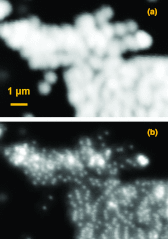Tuning donut profile for spatial resolution in stimulated emission depletion microscopy
- PMID: 23635197
- PMCID: PMC3637329
- DOI: 10.1063/1.4799665
Tuning donut profile for spatial resolution in stimulated emission depletion microscopy
Abstract
In stimulated emission depletion (STED)-based or up-conversion depletion-based super-resolution optical microscopy, the donut-shaped depletion beam profile is of critical importance to its resolution. In this study, we investigate the transformation of the donut-shaped depletion beam focused by a high numerical aperture (NA) microscope objective, and model STED point spread function (PSF) as a function of donut beam profile. We show experimentally that the intensity profile of the dark kernel of the donut can be approximated as a parabolic function, whose slope is determined by the donut beam size before the objective back aperture, or the effective NA. Based on this, we derive the mathematical expression for continuous wave (CW) STED PSF as a function of focal plane donut and excitation beam profiles, as well as dye properties. We find that the effective NA and the residual intensity at the center are critical factors for STED imaging quality and the resolution. The effective NA is critical for STED resolution in that it not only determines the donut shape but also the area the depletion laser power is dispersed. An improperly expanded depletion beam will have negligible improvement in resolution. The polarization of the depletion beam also plays an important role as it affects the residual intensity in the center of the donut. Finally, we construct a CW STED microscope operating at 488 nm excitation and 592 nm depletion with a resolution of 70 nm. Our study provides detailed insight to the property of donut beam, and parameters that are important for the optimal performance of STED microscopes. This paper will provide a useful guide for the construction and future development of STED microscopes.
Figures







Similar articles
-
Investigation on improvement of lateral resolution of continuous wave STED microscopy by standing wave illumination.Opt Express. 2018 Apr 16;26(8):9901-9919. doi: 10.1364/OE.26.009901. Opt Express. 2018. PMID: 29715937
-
Enhanced lateral resolution in continuous wave stimulated emission depletion microscopy using tightly focused annular radially polarized excitation beam.J Biophotonics. 2019 Sep;12(9):e201900060. doi: 10.1002/jbio.201900060. Epub 2019 May 28. J Biophotonics. 2019. PMID: 31050861
-
A simple empirical algorithm for optimising depletion power and resolution for dye and system specific STED imaging.J Microsc. 2019 Jun;274(3):168-176. doi: 10.1111/jmi.12795. Epub 2019 May 9. J Microsc. 2019. PMID: 31012103 Free PMC article.
-
Recent advances in STED and RESOLFT super-resolution imaging techniques.Spectrochim Acta A Mol Biomol Spectrosc. 2020 Apr 15;231:117715. doi: 10.1016/j.saa.2019.117715. Epub 2019 Nov 4. Spectrochim Acta A Mol Biomol Spectrosc. 2020. PMID: 31748155 Review.
-
Review of recent developments in stimulated emission depletion microscopy: applications on cell imaging.J Biomed Opt. 2014 Aug;19(8):080901. doi: 10.1117/1.JBO.19.8.080901. J Biomed Opt. 2014. PMID: 25121478 Review.
Cited by
-
Axial Optical Traps: A New Direction for Optical Tweezers.Biophys J. 2015 Jun 16;108(12):2759-66. doi: 10.1016/j.bpj.2015.05.014. Biophys J. 2015. PMID: 26083913 Free PMC article. Review.
-
Unimolecular Submersible Nanomachines. Synthesis, Actuation, and Monitoring.Nano Lett. 2015 Dec 9;15(12):8229-39. doi: 10.1021/acs.nanolett.5b03764. Epub 2015 Nov 13. Nano Lett. 2015. PMID: 26540377 Free PMC article.
-
Continuous-Wave Stimulated Emission Depletion Microscope for Imaging Actin Cytoskeleton in Fixed and Live Cells.Sensors (Basel). 2015 Sep 18;15(9):24178-90. doi: 10.3390/s150924178. Sensors (Basel). 2015. PMID: 26393614 Free PMC article.
-
A Fiber-Coupled Stimulated Emission Depletion Microscope for Bend-Insensitive Through-Fiber Imaging.Sci Rep. 2019 Jul 31;9(1):11137. doi: 10.1038/s41598-019-47319-w. Sci Rep. 2019. PMID: 31366899 Free PMC article.
-
Identifying DNA methylation in a nanochannel.Sci Technol Adv Mater. 2016 Oct 11;17(1):644-649. doi: 10.1080/14686996.2016.1223516. eCollection 2016. Sci Technol Adv Mater. 2016. PMID: 27877910 Free PMC article.
References
Publication types
MeSH terms
Grants and funding
LinkOut - more resources
Full Text Sources
Other Literature Sources

